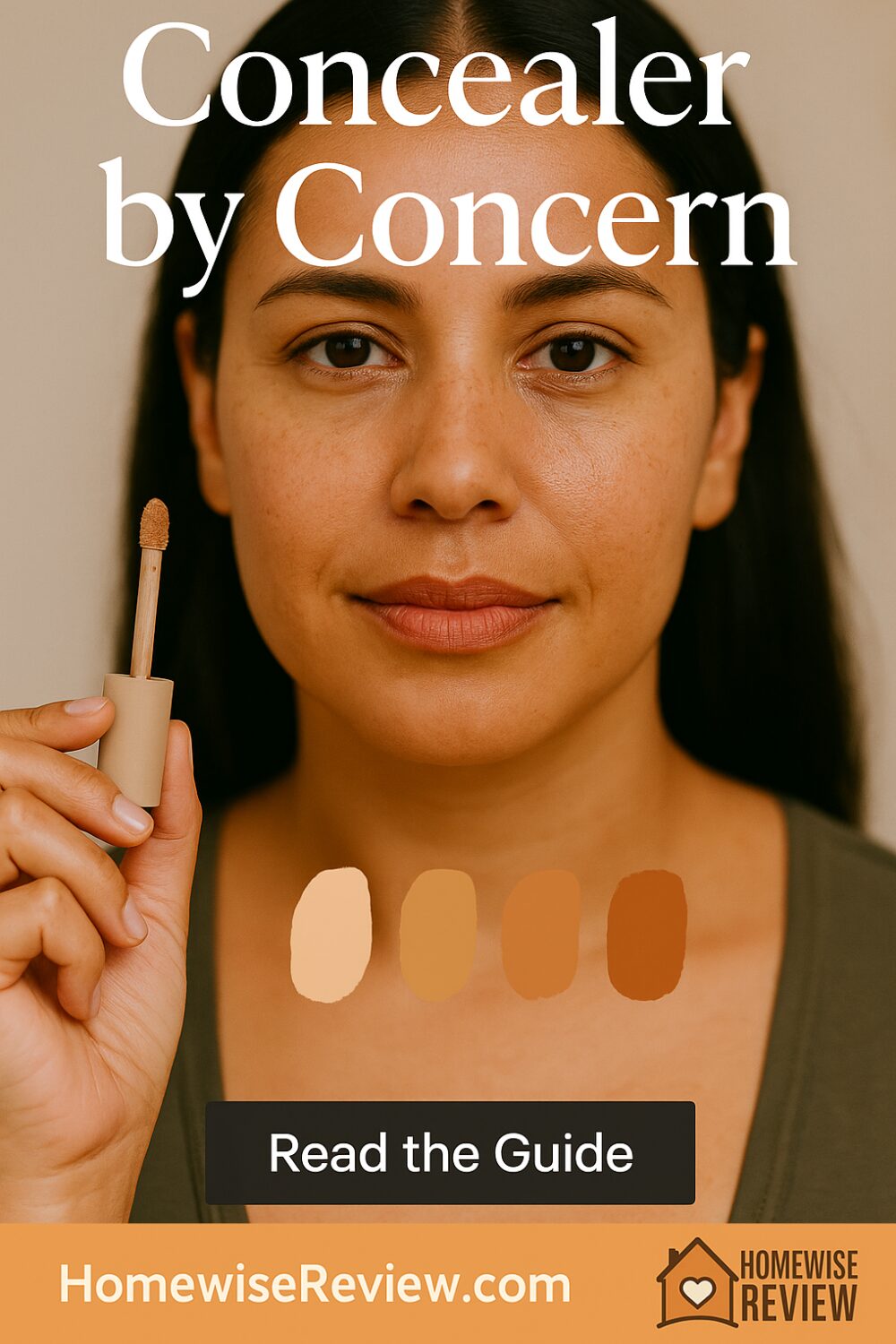
Who this is for: Busy women who want clear, repeatable steps to fix four common issues without caking or drawing attention to texture.
Bottom line: Match the tool to the job. Correct first only where needed, then use the thinnest possible layer of concealer with a finish that flatters the skin under it. Set only where you crease or fade.
Ratings reflect a summary of owner feedback and stylist commentary.
Quick map: pick the right approach
| Concern | Best prep | Corrector choice | Concealer type | How to set |
|---|---|---|---|---|
| Dark circles | Hydrating eye cream, let it sink 5 minutes | Peach to orange for blue/purple; bisque for brown | Thin liquid or serum concealer with medium coverage | Minimal powder just in the crease zone or a quick setting spray |
| Melasma or dark spots | Smooth, lightly moisturized skin | Peach or orange only if gray shows; often skip | High-coverage liquid or cream, neutral undertone | Micro-set with small brush and pressed powder |
| Redness | Calm moisturizer; optional green primer thinly | Sheer green corrector only on vivid areas | Medium liquid with yellow or olive lean | Light dusting across cheeks and around nose |
| Pimples | Oil-balanced base; no slip on the bump | None, or tiniest touch of green only on halo | Drier cream or stick; pinpoint with brush | Set with a tap of pressed powder only on the spot |
Shade and undertone basics
- Match concealer to your skin, not your foundation oxidized shade. If in doubt, go a hair lighter for under eyes and an exact match for spots.
- Peach cancels blue, orange cancels deep blue or gray on dark skin, yellow/olive mutes redness, green is for high-intensity red only and must be sheer.
- If coverage looks ashy, the corrector is too cool or too heavy. Swap to a warmer peach or use less.
Application rules that prevent cake
- Thin layers win. One whisper-thin pass of the right formula beats three thick ones.
- Work small. Treat each concern as its own mini project.
- Press, do not rub. Use a fingertip, detail brush, or a damp sponge tip to tap product in.
- Set surgically. Powder only where you crease or where oil breaks makeup apart.
Dark circles
Why it happens: Blue or purple from vessels, or brown from pigment. Texture under the eye magnifies mistakes, so hydration and thin layers matter.
How to do it
- Tap a tiny bead of eye cream, wait five minutes. Blot excess.
- Spot correct the darkest shadow only with peach or orange. Keep it sheer.
- Add a thin veil of medium-coverage liquid or serum concealer. Press from the inner corner outward.
- Set only the crease zone with a dusting of finely milled powder or lock with setting spray and a fingertip press.
Keep in mind
- Brown circles on deeper skin often need bisque or warm peach rather than brightening.
- Heavy powder ages the area. Use less than you think.
Melasma and dark spots
Why it happens: Hormonal and sun-linked patches that peek through most foundations.
How to do it
- Lay your usual base.
- If the patch looks gray, touch a sheer peach corrector first.
- Stipple high-coverage liquid or cream that matches your skin tone exactly. Work the edges until they melt.
- Micro-set with a tiny brush and pressed powder. Leave surrounding skin fresh so the eye reads even.
Keep in mind
- Brightening under eyes is great. Brightening on melasma is not. Aim for blend, not bright.
- Build in two thin passes rather than one thick coat.
Redness
Why it happens: Rosy undertones, weather, or irritants around the nose and cheeks.
How to do it
- Start with calming moisturizer. If redness is intense, smooth a sheer green primer only where needed.
- Press a yellow or olive-leaning liquid concealer over red zones. Keep the nose-crease area light to avoid texture.
- Set with a whisper of powder across the center face.
Keep in mind
- Skip heavy green layers. If you can see green, you used too much.
- Avoid rubbing during the day. Blot and press to refresh.
Pimples and post-blemish marks
Why it happens: Raised texture plus oil makes concealer slide or crust.
How to do it
- Clean base. No slick primer on the blemish.
- Use a tiny pinpoint brush with a drier cream or stick concealer. Dot only the raised area.
- Feather the edge with a clean finger.
- Tap a grain of pressed powder right on the spot to lock it.
Keep in mind
- Dewy concealers slip on bumps. Matte or natural-matte wins for active breakouts.
- If a scab is present, accept softer coverage. Texture will show up close.
Tools that make it easier
- Mini detail brush for pimples and dark-spot edges
- Damp micro sponge for under eyes and redness zones
- Pressed powder and a tiny brush for surgical setting
- Setting spray for a crease-free under eye when powder looks dry
Wear tests and touch-ups
- For long days, carry a mini sponge to press everything back together before adding more.
- If concealer separates, mist setting spray, press with sponge, then add a rice-grain amount of product only where needed.
- Oily noses and chins benefit from a blot sheet before any touch-up.
Final Thoughts
Correct only where color shows, then conceal with the thinnest layer that does the job. Match the finish to the skin under it, and set with intention, not habit. When you treat each concern separately, you get better coverage with less product and a face that still looks like skin.
See Also
If dark circles are your main battle, start with Makeup for Dark Circles: Correct, Conceal, Set (Without Caking) and the picks inside Best Concealer for Dark Circles: Brighten Fast, Stay Crease-Light. Fighting spots too? Our Best Dark Spot Correctors and Tranexamic Acid Serums for Stubborn Dark Spots cover skincare that helps discoloration fade over time while makeup handles the day to day.
For redness and pimple-prone skin, Best Toners for Oily & Acne-Prone Skin and Best Makeups for Acne-Prone Skin: Clearer Look, Lighter Feel will help you choose friendlier formulas. If your base is the issue, compare Best Foundations for Combination Skin: Shine Control Meets Healthy Glow and Best Foundation for Oily Skin to get your canvas right before you spot-conceal.
FAQs
Should concealer go before or after foundation
Usually after foundation so you use less. Correctors go on first, then foundation, then pinpoint concealer only where needed.
How do I stop under-eye creasing
Use thinner layers, press rather than swipe, and set only the crease line. If powder looks dry, swap to setting spray plus fingertip press.
Can I use the same shade for under eyes and blemishes
Not ideal. Under eyes can be slightly brighter. Blemishes need an exact skin match or they will show.
Do I need a corrector and a concealer
Only if color shows through. If a single product covers without ashiness, skip the corrector.
What brush is best for pimples
A tiny pointed brush lets you dot just the raised area, then feather the edge. Finish with a tap of pressed powder.
Affiliate Disclosure
If you purchase through links on our site, we may earn a small commission at no extra cost to you.




